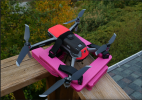As far as I know under the new regs, there is no such thing as a spotter anymore in the US.
I'm not sure what you mean by that?
§ 107.31 Visual line of sight aircraft operation
and,
§ 107.33 Visual observer
describe what's required.
§ 107.33 (a) The remote pilot in command, the person manipulating the flight controls of the small unmanned aircraft system, and the visual observer must maintain effective communication with each other at all times.
That's pretty much exactly what our Canadian Regulation says, except ours uses the words "
reliable and timely communication". So where did I get the idea that the US regs somehow require the pilot and visual observer to be
"co-located"?
Aha! It's in the Recreational exemption! The "Exception for limited recreational operations of unmanned aircraft", in
§44809(a)(3) requires, "
The aircraft is flown within the visual line of sight of the person operating the aircraft or a visual observer co-located and in direct communication with the operator."
So that seems to say that the "co-location" requirement applies only in the case when flying under the Recreational exemptions. Under full Part 107 they don't need to be co-located, and can be in radio communication? However...
§ 107.31(a) says, "
With vision that is unaided by any device other than corrective lenses, the remote pilot in command, the visual observer (if one is used), and the person manipulating the flight control of the small unmanned aircraft system must be able to see the unmanned aircraft throughout the entire flight in order to:"
That means, flying under
goggles and relying on the visual observer, the pilot
throughout the entire flight must also still "
be able to" see the drone when taking off the
goggles. So you cannot have visual observers with radios daisy-chained beyond possible VLOS of the pilot.
Our Canadian regulation says something significantly different, which I think makes more sense. Our
901.11 (1) says, "
[...], no pilot shall operate a remotely piloted aircraft system unless the pilot or a visual observer has the aircraft in visual line-of-sight at all times during flight."
The
pilot or a spotter must be able to see the drone. So we
can have a daisy-chained line of spotters in radio communication with the pilot when the drone is beyond VLOS of the pilot. They do not need to be co-located.













